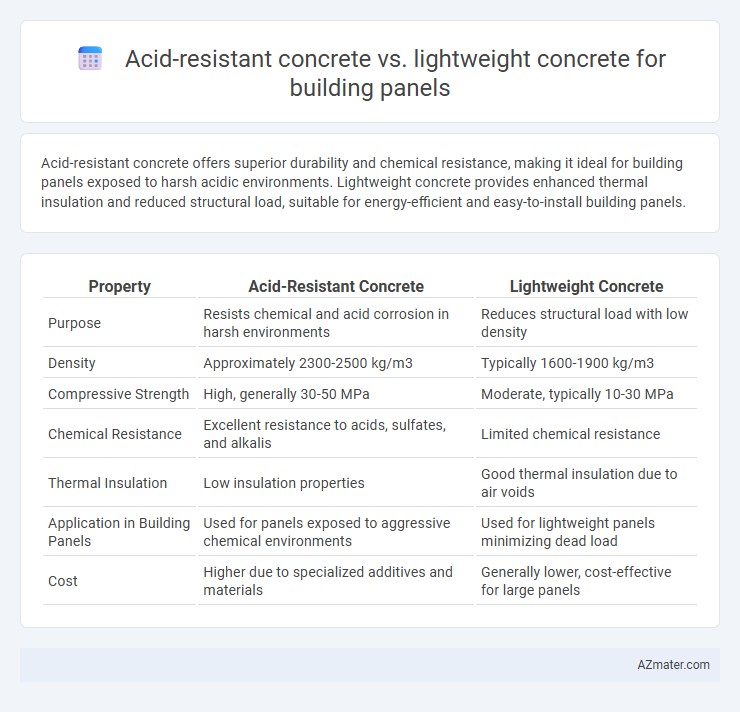Acid-resistant concrete offers superior durability and chemical resistance, making it ideal for building panels exposed to harsh acidic environments. Lightweight concrete provides enhanced thermal insulation and reduced structural load, suitable for energy-efficient and easy-to-install building panels.
Table of Comparison
| Property | Acid-Resistant Concrete | Lightweight Concrete |
|---|---|---|
| Purpose | Resists chemical and acid corrosion in harsh environments | Reduces structural load with low density |
| Density | Approximately 2300-2500 kg/m3 | Typically 1600-1900 kg/m3 |
| Compressive Strength | High, generally 30-50 MPa | Moderate, typically 10-30 MPa |
| Chemical Resistance | Excellent resistance to acids, sulfates, and alkalis | Limited chemical resistance |
| Thermal Insulation | Low insulation properties | Good thermal insulation due to air voids |
| Application in Building Panels | Used for panels exposed to aggressive chemical environments | Used for lightweight panels minimizing dead load |
| Cost | Higher due to specialized additives and materials | Generally lower, cost-effective for large panels |
Introduction to Building Panels
Acid-resistant concrete and lightweight concrete serve distinct roles in building panel construction, addressing different performance requirements. Acid-resistant concrete is formulated with special aggregates and chemical compositions to withstand aggressive chemical environments, making it ideal for industrial and laboratory panels exposed to corrosive substances. Lightweight concrete offers reduced density and enhanced thermal insulation, providing structural efficiency and energy savings in residential and commercial building panels.
Overview of Acid-Resistant Concrete
Acid-resistant concrete is specially formulated with chemical-resistant aggregates and binders to withstand exposure to highly acidic environments, making it ideal for industrial building panels where chemical corrosion is a concern. Its composition often includes silica fume, corrosion inhibitors, and polymer additives that enhance durability and prolong lifespan under acidic assault. This type of concrete provides superior protection compared to lightweight concrete, which prioritizes reduced weight and thermal insulation rather than chemical resistance.
Overview of Lightweight Concrete
Lightweight concrete is characterized by its reduced density, typically ranging from 1,440 to 1,840 kg/m3, achieved by incorporating lightweight aggregates like expanded clay, shale, or pumice. This type of concrete provides enhanced thermal insulation and reduces the dead load on structures, making it ideal for building panels where weight savings are crucial. Unlike acid-resistant concrete, which prioritizes chemical durability, lightweight concrete emphasizes structural efficiency and energy performance in construction applications.
Key Material Properties Compared
Acid-resistant concrete features high chemical durability and low permeability, making it ideal for structures exposed to corrosive environments, while lightweight concrete offers reduced density and enhanced thermal insulation, improving structural efficiency and energy performance. Acid-resistant concrete typically incorporates dense aggregates and specialized cementitious materials to resist chemical attack, whereas lightweight concrete uses expanded aggregates like perlite or vermiculite to achieve lower weight. The compressive strength of acid-resistant concrete generally surpasses that of lightweight concrete, but lightweight panels provide superior thermal and acoustic insulation benefits crucial for energy-efficient building designs.
Durability in Aggressive Environments
Acid-resistant concrete offers superior durability in aggressive environments by utilizing specialized cementitious materials and chemical-resistant aggregates that withstand acidic attacks, preventing structural degradation over time. Lightweight concrete, while beneficial for reducing dead load, generally exhibits lower chemical resistance and may suffer from increased permeability, leading to faster deterioration when exposed to acidic or corrosive substances. Selecting acid-resistant concrete for building panels ensures enhanced longevity and structural integrity in harsh industrial or chemical exposure conditions.
Weight and Structural Load Considerations
Acid-resistant concrete offers superior durability against chemical corrosion with a higher density, resulting in increased weight and greater structural load on building panels. Lightweight concrete significantly reduces panel weight, decreasing structural demands and easing installation, but may require protective coatings to withstand acidic environments. Choosing between these materials depends on balancing the need for chemical resistance against overall weight constraints and load-bearing capacity in construction design.
Thermal and Acoustic Performance
Acid-resistant concrete offers superior durability in corrosive environments but generally exhibits lower thermal insulation compared to lightweight concrete, which contains air pockets that reduce heat transfer significantly. Lightweight concrete enhances thermal performance by lowering the panel's overall density, providing better energy efficiency and maintaining stable indoor temperatures. Acoustic insulation is also improved in lightweight concrete due to its porous structure, effectively dampening sound transmission and creating quieter indoor environments compared to the denser, more rigid acid-resistant panels.
Installation and Handling Differences
Acid-resistant concrete panels require specialized handling equipment to prevent damage due to their dense and brittle composition, whereas lightweight concrete panels are easier to transport and install because of their reduced weight. Installation of acid-resistant panels often demands precise alignment and sealing techniques to maintain chemical resistance, while lightweight panels offer greater flexibility and faster placement speeds on-site. Handling lightweight concrete reduces labor fatigue and risk of injury compared to the more cumbersome acid-resistant panels that necessitate careful maneuvering to avoid surface cracking.
Cost Analysis and Lifecycle Value
Acid-resistant concrete offers enhanced durability against chemical corrosion, leading to reduced maintenance costs and extended service life in industrial environments, while lightweight concrete provides cost savings through easier handling and faster installation, which lowers labor expenses. The higher initial material cost of acid-resistant concrete is offset by its superior lifecycle value in aggressive settings, whereas lightweight concrete's value is maximized in applications prioritizing thermal insulation and structural efficiency. Evaluating total cost of ownership, acid-resistant concrete delivers long-term economic benefits in corrosive conditions, whereas lightweight concrete optimizes upfront costs and energy efficiency for standard building panels.
Ideal Applications for Each Concrete Type
Acid-resistant concrete is ideal for industrial flooring, chemical plants, and wastewater treatment facilities where exposure to corrosive substances requires durable, non-reactive materials. Lightweight concrete suits building panels in residential and commercial constructions demanding thermal insulation, reduced structural load, and enhanced fire resistance. Selecting the appropriate concrete type depends on project-specific factors such as chemical exposure risks or thermal performance needs.

Infographic: Acid-resistant concrete vs Lightweight concrete for Building panel
 azmater.com
azmater.com